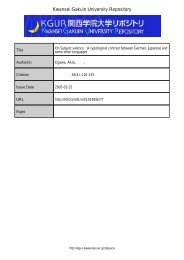Kwansei Gakuin University Repository
Kwansei Gakuin University Repository
Kwansei Gakuin University Repository
Create successful ePaper yourself
Turn your PDF publications into a flip-book with our unique Google optimized e-Paper software.
holds for all situations. In addition, because there are three forms of exit in our data<br />
set, the occurrence of one of these forms precludes us from observing another form<br />
of exit. For example, once a firm exits the market by merger, the duration until<br />
bankruptcy or voluntary liquidation cannot be traced. For this reason, Esteve-Pérez<br />
et al. (2009) proposed to use the CPH model to identify factors affecting each form<br />
of exit. The CPH model has been used to deal with the presence of competing events<br />
that impede the event of interest. 11 Following Esteve-Pérez et al., we use the CPH<br />
model to estimate the determinants of exit among new firms. 12<br />
Suppose that firm i is at risk of m different forms of exit. In this paper, we<br />
consider three forms of exit—bankruptcy, voluntary liquidation, and merger—that<br />
is, m = 3. Let xij denote a vector of covariates affecting form j(= 1, . . . , m) of exit.<br />
In the CPH model, the hazard function, λij, at time t is assumed to be written as:<br />
λij(t) = λ0j(t) exp (xijβj) , (1)<br />
where both λ0j(t), which is called the baseline hazard function, and βj (vector) are<br />
specific to form j hazard. Suppose that kj refers to the number of firms that exit<br />
by form j (e.g., bankruptcy) during the observation period. Let tj1, . . . , tjkj denote<br />
the kj ordered exits of form j. The partial likelihood function of form j for the CPH<br />
model, Lj, is given by:<br />
Lj =<br />
kj ∏<br />
h=1<br />
λ0j(t) exp (xjhβj)<br />
∑<br />
l∈R(tjh) λ0j(t) exp (xlβj) =<br />
kj ∏<br />
h=1<br />
exp (xjhβj)<br />
∑<br />
l∈R(tjh)<br />
exp (xlβj) , (2)<br />
where R(tjh) is the set of firms at risk of exit at time tjh. By maximizing the<br />
logarithm of the likelihood function, we obtain the estimated results for form j.<br />
Because it is considered that the probability of exit depends heavily on the firm’s<br />
life-cycle stage, time is measured by firm age in this paper. That is, t corresponds to<br />
11 For more details on the CPH model, see, for example, Cameron and Trivedi (2005).<br />
12 Esteve-Pérez et al. emphasized that the presence of left-truncated observations—firms that<br />
started businesses before the beginning of the observation period—is not a problem. However, if<br />
the determinants of exit depend on the firm’s age, the left truncation would be problematic. In<br />
contrast to their analysis, we can avoid the left-truncation problem, because we focus only on new<br />
firms, which results in the identification of the starting year of the firms in our data set.<br />
12
















